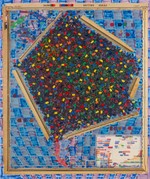Course Description
Hello and welcome to DCS 210. Programming for Data Analysis and Visualisation. This course will introduce students to data analysis and visualization with R. By the end of the course students will be able to gain insight from data, reproducibly (with literate programming and version control) and collaboratively, using modern programming tools and techniques. As an introduction to programming course, everyone is welcome.
The course content is organized in five units:
- Unit 1 - Hello world: This unit is an introduction to the content, pedagogy, and toolkit of the course.
- Unit 2 - Exploring data: This unit focuses on data visualization and data wrangling. Specifically we cover fundamentals of data and data visualization, confounding variables, and Simpson’s paradox as well as the concept of tidy data, data import, data cleaning, and data curation. We end the unit with web scraping and introduce the idea of iteration in preparation for the next unit. Also in this unit students are introduced to the toolkit: R, RStudio, R Markdown, Git, and GitHub.
- Unit 3 - Data science ethics: In this unit we discuss misrepresentation of findings, particularly in data visualisations, breaches of data privacy, and algorithmic bias.
- Unit 4 - Making rigorous conclusions: In this unit we introduce modelling and statistical inference for making data-based conclusions. We discuss building, interpreting, and selecting models, visualizing interaction effects, and prediction and model validation. Statistical inference is introduced from a simulation based perspective, and the Central Limit Theorem is discussed very briefly to lay the foundation for future coursework in statistics.
- Unit 5 - Looking forward: In the last unit we will explore a series of short modules. These will be chosen by you and could include modules such as interactive reporting and visualization with Shiny, text analysis, creating maps, and machine learning.
DCS Values, Goals, and Practices
The primary purpose of Digital and Computational Studies is to bridge the liberal arts education to computing and the digital world. In this, we are committed to actively creating digital and computational spaces that are radically inclusive. Our core commitment is to integrating equity and social justice throughout our curriculum, and engaging students in metacognition to support this work. Digital and Computational Studies Courses fall into a continuum of experiences that range from critical digital studies to programming, with an integrated core that embraces both. Programming for Data Analysis and Visualization is an Integrated course. See the DCS website for details on DCS values, goals, and practices.
Learning Objectives
This course is designed as a community learning journey. Together, we will:
- Play with computational ideas creatively, using a growth mindset which values revision and experimentation.
- Gain experience in data collection, wrangling, visualization, exploratory data analysis, predictive modeling and effective communication of results while working on problems and case studies inspired by and based on real-world questions.
- Engage and reflect on contemporary issues in environmental and social justice related to your digital world, community and positionality. Critically evaluate the origins of data and the limitations of analysis techniques.
- Demonstrate community leadership skills as a collaborator that shares strengths, builds weaknesses, and contributes to a broader shared understanding.
It is also my hope that in this course you:
- Develop an appreciation for reproducibility, transparency, accessibility and inclusivity in data collection, analysis, and communication.
- Build knowledge and skills in data science skills to tackle questions that are important to you.
Course Materials required:
Books:
All books for this course are freely available online as e-books. We will be using two main texts:
Technology:
- Bring a laptop to every class, we will be programming most days! We will initially be using RStudioCloud, you will get an invitation to create an account. If you have any difficulties with accessing one, let me know, or feel free to borrow a chrome book from the library.
- Later on in the course when you’re doing your group projects you will have the option to install R and RStudio on your laptop.
Course components
Weekly structure
This course takes a flipped classroom approach where the lectures are watched outside of class and we will work on the hands-on coding and review in class. The class meets on Tuesday and Thursday from 9.30-10:50. The typical weekly class schedule will be:
| Day |
Activity |
| Tuesday |
Review/Application Exercise/Code Along |
| Thursday |
Lab |
| Wednesday |
Student hours |
Outside of class you can expect to spend
- 1-1.5 hours per week watching lectures;
- 1-2 hours on the reading and interactive tutorials per week
- 3-5 hours on homework and labs each week.
- Homework: is assigned on Tuesday and due the following Friday at 23.59pm EST.
- Labs: Labs will be started in class on Thursday and are due the following Wednesday at 23.59pm EST.
Pre-recorded videos
You will want to start watching videos for the following week on Thursday in preparation for the following Tuesday’s review session (5 days after Thursday). To keep your learning active, we’ll use Tuesday’s class times to review the material covered in the lectures and readings, and to work on application exercises that you can complete on RStudio Cloud. It is important that you keep up with the content assigned outside of class so that you are prepared for the labs and homework that week. The concepts covered in the course build on one another. If you feel yourself falling behind, please attend a review session with Ashka or book an appointment with me during student hours. We are happy to help with any of the concepts!
Student hours
Student hours will be held on Wednesdays from 7-8.30pm. You can book an appointment in my calendar on calendly.
Student hours are a time to talk about the course content, a homework/grade, concerns about the course or personal matters, advice on your thesis or another data project, and next steps (internships, careers, majors, future classes). Meeting with students one on one is one of my favorite parts of the course, so do come by with any questions!
Code along sessions
We will periodically have code-along sessions on Tuesday where we will tackle a new data set and data visualization together. These sessions are a chance to learn about workflow and debugging techniques since there will inevitably be lots wrinkles to iron out during unstructured live coding.
Labs
These will be held on Thursdays. During these sessions you will work individually or in teams on computing lab exercises and you will finish the exercises after class and turn in your lab reports by Wednesday at 23:59 EST. Attendance to class is important as you will be working on your labs individually and together in class. Labs will be submitted as GitHub repositories and the lowest score for each student will be dropped. Tip: Set up a weekly team meeting between Thursday and Wednesday to work with your team to finish the assignment.
A frequently asked question is “What happens if I can’t make it to a lab one week because I’m sick or have another obligation at that time?” Answers below:
- If you’re missing a workshop day due to short-term illness or some other reason, you should communicate this with your team and attend a team meeting before the deadline for the assignment to contribute to the teamwork. If you have made 0 commits towards a lab assignment, you will receive a 0 for that assignment, so you need to participate both for being a team player and also for your own individual score.
- You are allowed to drop one lab score, this will automatically be the lab with the lowest score. If you know you are going to miss a lab day and plan to drop that lab, you should let me know in advance so that I can organize and assign teams accordingly.
- If you’re unable to contribute to a lab assignment because of an illness taking you away from school work for an extended period of time, you should let me and your team know that you won’t be able to contribute to those lab(s) and we can discuss special circumstances and explore alternative arrangements to make up that work.
Overall these policies are put in place to ensure communication between team members, respect for each others' time, and also to give you a safety net in the case of illness or other reasons that keep you away from attending class once or twice.
Application Exercises:
In addition to reviewing the video lecture material in class, we will also be working on application exercises together in class. Application exercises will be completed on RStudio Cloud.
Homework assignments
Beyond the in class activities, you will be assigned weekly larger programming tasks throughout the semester. These assignments will be completed individually, and submitted as GitHub repositories. Homework assignments with the lowest score for each student will be dropped. Tip: Do the (optional) R tutorials which will introduce you to the datasets and topics covered in the homework assignments.
Quizzes
These weekly multiple choice quizzes will help you evaluate your learning continuously. The online quiz will be graded for completion. Tip: Don’t leave it till the last minute!
Reflections
Throughout the course there will be reflection assignments where we engage and reflect on contemporary issues in environmental and social justice related to our digital world, community and identity.
Final project
You will be responsible for the completion of an open ended final project for this course, the goal of which is to tackle an “interesting” problem using the tools and techniques covered in this class. Additional details on the project will be provided as the course progresses. Each team’s work will also be shared with and evaluated by at least one other team at an earlier stage in order to provide feedback in the form of code review. You must complete the final project and be in class to present it in order to pass this course. Tip: Stick to optional interim deadlines (outline, draft presentation) to pace your work on the project.
Teams
For all of the team based assignments in this class you will be randomly assigned to teams of 2 or 3 students - these teams will change throughout the semester. You will work in these teams during class and on the lab assignments. For team based assignments, all team members are expected to contribute equally to the completion of each assignment and you will be asked to evaluate your team members on lyceum after each assignment is due. During the labs, we will be working together using pair programming, where you will take it in turns to write and review the the code, swapping roles frequently. Once the assignment is submitted the contributors will share responsibility for any revisions to be made based on feedback. Failure to adequately contribute to an assignment will result in a penalty to your grade relative to the team’s overall grade.
Students are expected to make use of the provided GitHub repository as their central collaborative platform. Commits to this repository will be used as a metric (one of several) of each team member’s relative contribution for each homework.
Grade:
Your overall course grade will be comprised of the following components, and their weights:
- Homework: 30%
- Lab: 20%
- Project: 30%
- Quiz: 10%
- Attendance: 5%
- Reflections: 5%
Tutoring in the local school and completing a reflection can count for 5% credit on the course. This credit can be counted in place of a homework assignment. Go to the extra credit tab to find out more.
Grading scale:
Lower bound percent earned for letter grade:
A 93 A- 90 B+ 87 B 83 B- 80 C+ 77 C 73 C- 70 D+ 67 D 63 D- 60 F below 60
A+ reserved for exceptional work
Policies
Collaboration policy
Only work that is clearly assigned as team work should be completed collaboratively. Individual assignments must be completed individually, you may not directly share or discuss answers / code with anyone other than the instructors and tutors. You are welcome to discuss the problems in general and ask for advice.
Sharing / reusing code
I am well aware that a huge volume of code is available on the web to solve any number of problems. Unless I explicitly tell you not to use something the course’s policy is that you may make use of any online resources (e.g. StackOverflow) but you must explicitly cite where you obtained any code you directly use (or use as inspiration). Any recycled code that is discovered and is not explicitly cited will be treated as plagiarism. On individual assignments you may not directly share code with another student in this class, and on team assignments you may not directly share code with another team in this class. You are welcome to discuss the problems together and ask for advice, but you may not send or make use of code from another team.
Academic integrity
Bates College takes academic misconduct very seriously and is committed to ensuring that so far as possible it is detected and dealt with appropriately.
Cheating or plagiarizing on assignments are a breach of trust with classmates and faculty, violate the University policies, and will not be tolerated. Make sure to review the Student Guide to Academic Integrity Policies and Procedures on the Bates website. Such incidences will result in a 0 grade for all parties involved.
Universal Learning and Learning in Community
Many of us learn in different ways. For example, you may process information by speaking and listening, so while lectures are quite helpful for you, some of the written material may be difficult to absorb. You might have difficulty following lectures, but are able to quickly assimilate written information. You may need to fidget to focus in class. You might take notes best when you can draw a concept. For some of you, speaking in class can be a stressful or daunting experience. For some of you, certain topics or themes might be so traumatic as to be disruptive to learning. The principle of Universal Design for Learning calls for our classrooms, our virtual spaces, our practices and our interactions to be designed to include as many different modes of learning as possible, and is a principle I take seriously in this class.
It is also my goal to create an inclusive classroom, which depends on community building, and which requires everyone to come to class with mutual respect, civility, and a willingness to listen to and observe others. As such the syllabus serves as a contract of some expectations between all members of the class, including myself.
If you anticipate or experience any barriers to learning in this course, please reach out to me and your student support advisor. If you have a disability, or think you may have a disability, you may also want to meet with Abigail Nelson, Assistant Dean of Accessible Education and Student Support, to begin this conversation or request an official accommodation. You can find more information about the Office of Accessible Education and Student Support, including contact information, on the accessible education page of the Bates website. If you have already been approved for accommodations through the Office of Accessible Education please let me know! We can meet 1-1 to explore concerns and potential options. If you do not have a documented disability, remember that student support services are available to all students through the Math and Stats Workshop (R, Math, and Stats).
The college prohibits discrimination on the basis of race, color, national or ethnic origin, religion, sex, sexual orientation, gender identity or gender expression, age, disability, genetic information or veteran status and other legally protected statuses in the recruitment and admission of its students, in the administration of its education policies and programs, or in the recruitment of its faculty and staff. Bates College adheres to all applicable state and federal equal opportunity laws and regulations. Violations of this policy can be reported to Gwen Lexow, Director of Title IX and Civil Rights Compliance or through the Bates website: www.bates.edu/sexual-respect/non-discrimination-policy/
Late work, extensions, and special circumstances
All work is due on the stated due date. Due dates are there to help guide your pace through the course and they also allow me (the course professor) to return marks and feedback to you in a timely manner. However, sometimes life gets in the way and you might not be able to turn in your work on time. Note, first of all, that the lowest score of labs and homework assignments is dropped. So if you miss one assignment, this can be your dropped score. Resubmission is built into each assignment. You will first receive feedback on each assignment before receiving a final grade. All resubmissions are due 7 days after feedback is received. It is your responsibility to keep track of this deadline. For instance, if a homework is due on
If you intend to submit work late for an assignment or project, you must notify me before the original deadline and as soon as the completed work is submitted on GitHub. Lab work cannot be submitted late, Note also that each of you have 3 late days you can put towards homework assignments during the semester without receiving a late penalty.
Learning during a pandemic
I want to make sure that you learn everything you were hoping to learn from this class. If this requires flexibility, please don’t hesitate to ask.
-
You never owe me personal information about your health (mental or physical) but you’re always welcome to talk to me. If I can’t help, I likely know someone who can.
-
I want you to learn lots of things from this class, but I primarily want you to stay healthy, balanced, and grounded during this crisis.











